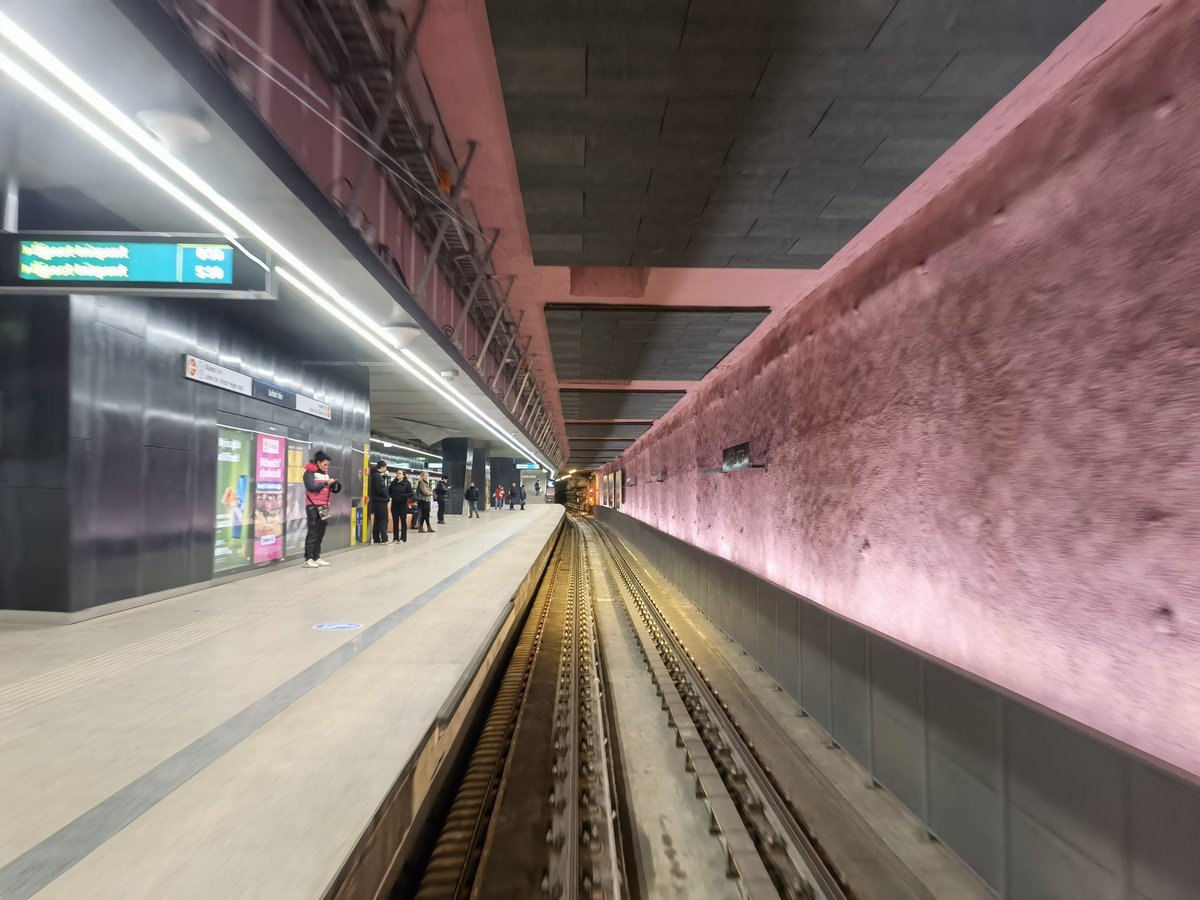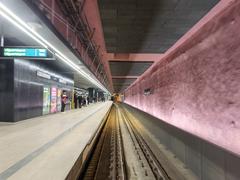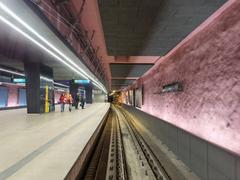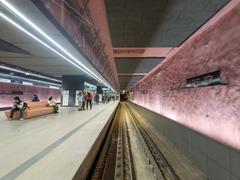
Lehel Tér Budapest: Visiting Hours, Tickets, and Historical Sites Guide
Date: 15/06/2025
Introduction: Lehel Tér’s Urban and Historical Significance
Lehel Tér, located in Budapest’s 13th district, is a dynamic and historically layered public square that bridges the city’s past and present. Originally named Ferdinánd tér in the late 19th century, the square has been renamed and reimagined through successive political eras, from the socialist Élmunkás tér to its current name, honoring the Hungarian chieftain Lehel. This evolution reflects broader shifts in Hungary’s social, urban, and political landscape, making Lehel Tér a compelling destination for those interested in architecture, local life, and the city’s living heritage (Wikipedia; Progressive Productions).
As a bustling transport interchange and commercial hub, Lehel Tér is renowned for its modernist metro station and the architecturally iconic Lehel Market Hall. The square pulses with the energy of daily commuters, market-goers, and residents, offering visitors a unique window into Budapest’s everyday rhythms and vibrant community life. This guide details Lehel Tér’s historical development, architectural highlights, visiting hours, accessibility, transport options, and practical tips to help you make the most of your visit (Budapest City; Nomadic Matt).
Table of Contents
- Historical Background
- Architectural Evolution
- Practical Visitor Information
- Visuals and Multimedia
- Frequently Asked Questions (FAQ)
- Significance in Budapest’s Urban Landscape
- Lehel Market Hall and Szent Margit Church: Hours, Admission, and Tips
- Transport and Local Insights
- Summary and Key Takeaways
- Sources and Further Reading
Historical Background
Origins and Early Development
Lehel Tér’s roots extend to the late 19th century, when it was established as Ferdinánd tér. This period was marked by Budapest’s rapid urbanization following the 1873 unification of Buda, Pest, and Óbuda. The square was named in honor of Ferdinand I of Austria, reflecting the city’s Austro-Hungarian influences. Its growth was closely linked to the emergence of the Angyalföld neighborhood as an industrial and working-class center (Wikipedia).
Earlier, the site accommodated Pest’s first central cemetery, with burials ceasing by 1841 and the grounds closing in 1871. The transition from cemetery to public square set the stage for Lehel Tér’s evolution into an urban node and market space (We Love Budapest).
20th Century Transformations
Post-World War II, the square was renamed Élmunkás tér (“Model Worker’s Square”) in 1951, reflecting socialist-era values and the broader rebranding of public spaces throughout Budapest. This era brought substantial architectural change—large-scale residential blocks and functionalist public buildings characterized by minimal ornamentation and an emphasis on mass housing. The square became increasingly important as a transport interchange, connecting tram and bus lines to serve the growing population (Progressive Productions).
Following the political changes of 1989–1990, the square adopted the name Lehel Tér, commemorating the legendary chieftain from the Magyar conquest. This renaming echoed a nationwide movement to reclaim national heritage and identity (Wikipedia).
Architectural Evolution
Urban Fabric and Early Structures
Lehel Tér’s urban structure is defined by major thoroughfares—Váci út, Bulcsú utca, and Lehel utca—making it a central point for movement and commerce. Early architecture in the area included eclectic residential tenements and small commercial outlets, contributing to a lively but modest streetscape (Wikipedia).
Socialist-Era Developments
The mid-20th century saw the construction of concrete-panel apartment blocks and utilitarian buildings, prioritizing efficiency and housing needs. The square’s role as a transport hub expanded, with tram and bus lines converging to facilitate mobility for Angyalföld and beyond (Progressive Productions).
The Metro Station: Modernist Landmark and Renovation
The Lehel tér metro station opened in 1981 as part of the M3 (Blue) line’s third phase. Initially named Élmunkás tér, it was designed with robust materials and a focus on function, mirroring the modernist ethos of the time (Wikipedia).
A major renovation between 2021 and 2023, led by sporaarchitects Ltd. and Paragram, transformed the station while honoring its original logic (Mies Arch). The redesign exposed raw structural elements and introduced vibrant colors inspired by the original designer Adél Németh. The result is a dynamic space that balances industrial heritage with contemporary aesthetics, making the station a model for public infrastructure renewal.
Lehel Market Hall: Postmodern Icon
Adjacent to the square stands Lehel Market Hall (Lehel Csarnok), designed by László Rajk Jr. and completed in 2002. Its ship-like form and bold colors contrast with the surrounding architecture, making it a divisive yet celebrated landmark (Rajk Info). The market hall, often called “kofahajó” (traders’ ship), serves as both a commercial center and a symbol of Budapest’s willingness to embrace creative, site-specific architecture (Progressive Productions).
Inside, the market is a vibrant meeting point for fresh produce, local delicacies, and everyday social interaction (Budapest City).
Urban Renewal
Lehel Tér remains the focus of ongoing urban renewal efforts, with recent years seeing upgrades to public spaces, infrastructure, and green areas (We Love Budapest). The integration of renovated transport nodes and contemporary market architecture exemplifies Budapest’s approach to balancing preservation with modernization.
Practical Visitor Information
Visiting Hours and Tickets
- Lehel Tér Square: Open 24/7 year-round.
- Lehel Market Hall: Monday–Saturday, 6:00–18:00; closed Sundays.
- Lehel tér Metro Station: Daily, 4:30–24:00.
- Entry: No admission fees for the square, market, or metro station with a valid transport ticket.
How to Get There
- Metro: M3 (Blue) line, Lehel tér station.
- Trams: Lines 14 and 75 nearby.
- Buses: Multiple routes serve the area.
- Cycling: MOL Bubi bike-share docking stations available.
- Walking: Wide sidewalks and safe crossings.
Accessibility
- Physical: Market hall and metro station are fully accessible, with elevators, ramps, and tactile paving (Wind and Whim; M3felujitas.hu).
- Sensory/Cognitive: Pictogram signage and audio announcements in the metro; early morning visits recommended for visitors sensitive to crowds.
Nearby Attractions
- Margaret Island (recreation, parks)
- Angyalföld neighborhood (local eateries, shops)
- Váci út shopping district
- Nyugati Railway Station
- St. Stephen’s Basilica and Danube promenade (via M3)
Guided Tours
While no dedicated tours focus solely on Lehel Tér, many city tours include the square due to its architectural and historical significance.
Visuals and Multimedia
Alt tags: “Lehel tér Budapest”, “Lehel Market Hall Budapest”, “Lehel tér visiting hours”
Frequently Asked Questions (FAQ)
Q: What are the visiting hours of Lehel Tér and the market hall?
A: The square is open 24/7; the market hall is open Monday–Saturday, 6:00–18:00.
Q: Is there an entry fee for Lehel Tér or the metro station?
A: No, but a valid public transport ticket is required for the metro.
Q: How do I get to Lehel Tér?
A: Take the M3 metro, tram lines 14 or 75, or various bus routes.
Q: Are guided tours available?
A: Occasionally, as part of broader Budapest city tours.
Q: Is Lehel Market accessible for people with disabilities?
A: Yes, with elevators, ramps, and barrier-free access.
Significance in Budapest’s Urban Landscape
Lehel Tér exemplifies Budapest’s unique blend of history, architecture, and vibrant community life. Its evolution from cemetery and market square to transport hub and postmodern landmark mirrors the city’s resilience and adaptability. The striking contrast between 19th-century tenements, socialist-era blocks, and bold contemporary designs demonstrates Budapest’s ongoing negotiation between preservation and innovation (Wikipedia; Progressive Productions).
For visitors, Lehel Tér offers an authentic slice of daily Budapest, far from the city’s more touristy sites. The market hall functions as a social and culinary anchor, while the metro station ensures seamless connectivity. With improved accessibility and diverse transport options, Lehel Tér is an inviting destination for all travelers (M3felujitas.hu; Wind and Whim).
Lehel Market Hall and Szent Margit Church: Hours, Admission, and Tips
Lehel Market Hall
- History: Opened in 2002, designed by László Rajk Jr., replacing an open-air market (Rajk Info).
- Layout: Three levels with over 200 stalls; offers Hungarian and international foods, flowers, and household goods.
- Hours: Monday–Saturday: 6:00–18:00; Sunday: 6:00–14:00.
- Payment: Many vendors accept cards, but cash (HUF) is preferred.
- Tips: Try local specialties (lángos, sausages, goulash), visit early for the freshest produce, and always ask vendors before photographing.
Szent Margit Church
- History: Consecrated in 1933, designed by István Möller, Neo-Gothic style, named after Saint Margaret of Hungary (margitos.hu).
- Hours: Monday–Saturday: 6:30–19:00; Sunday: 7:00–21:00.
- Admission: Free, but not fully accessible for those with mobility impairments.
- Etiquette: Modest dress is recommended; photography allowed outside of religious ceremonies.
Combine your visit: Both sites are steps apart and ideal for a combined tour.
Transport and Local Insights
- Metro: Line M3, frequent service (BKK Timetables).
- Tram/Bus: Lines 15, 115, 76, and nearby tram lines 4 and 6 (Budapestbylocals.com).
- Airport: 100E shuttle to Deák Ferenc tér, then Metro M3 to Lehel Tér (Just Budapest).
- Cycling: MOL Bubi bike-share stations nearby.
- Local Tips: Visit in the morning, bring cash, and check out nearby terraces and cafés for authentic experiences (Wingman’s Fav Local Market).
Summary and Key Takeaways
Lehel Tér is a microcosm of Budapest’s history, architectural evolution, and urban vitality. Its journey from Ferdinánd tér through socialist transformation to its current status reflects Hungary’s broader societal changes. The market hall and metro station highlight the city’s ability to preserve heritage while embracing innovation. For an authentic experience of Budapest’s daily life, rich culinary traditions, and community spirit, Lehel Tér is an unmissable destination (Audiala App; We Love Budapest).
Sources and Further Reading
- Wikipedia: Lehel Tér Metro Station
- Progressive Productions: Budapest Architecture History
- Mies Arch: Lehel Tér Metro Station Renovation
- Rajk Info: Lehel Market Hall Budapest
- We Love Budapest: Urban Renewal
- We Love Budapest: Lehel Market Guide
- Wind and Whim: Lehel Market Accessibility
- M3felujitas.hu: Metro Line M3 Accessibility
- Nomadic Matt: Budapest Travel Itinerary
- Budapest City: Lehel Market Hall
- margitos.hu: Szent Margit Church
- BKK Timetables
- Budapestbylocals.com: Public Transport
- Just Budapest: Public Transport
- Wingman’s Fav Local Market
- Audiala App
For guided audio tours, real-time updates, and more travel inspiration, download the Audiala app and follow us on social media. Enjoy your journey through Lehel Tér and discover Budapest’s living history!










































































































































































